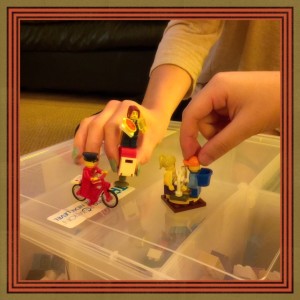
What makes a powerful, rigorous, and relevant math station activity?
1. Identify the content standard.
One of the activities that uses building blocks to concretely explore a concept is the Math Common Core State Standard from fourth grade, MCC4.OA.1a: Use the four operations with whole numbers to solve problems.
2. Research the way in which the standard will be assessed during high-stakes district and state testing.
Here is a sample of a word problem that assesses a student’s understanding of MCC4.OA.1.
Chris can go four miles on his bike. Jill can go seven times faster on her electric scooter. How fast can Jill go on her motorcycle? Which one would you rather ride and why?
I added the last question to provide a student with a connection to the problem and to raise the level of thinking about the problem. I train students to “add” these types of questions to word problems that may not have them so they care about the answer. Believe it or not, this truly helps the accuracy and on-task behavior of students.
3. Think about any pictures or graphics that would assist the student in solving these types of problems.
Most testing situations give students scratch paper of space on the testing booklet on which to draw pictures or make calculations. Thinking about what they can use whenever they encounter this type of problem will help form critical thinking habits.
4. Determine if there are any manipulatives, or other hands-on methods, that would offer students a concrete way to explore this concept.
For the problem above, students are given a set of lego-type building blocks and a building block base. They select a building block with four dots on it to represent the bicycle speed.
They then select seven more of the four-dot blocks to represent the speed of the motorcycle. If they simple count the dots on the seven blocks, they will know the speed of the motorcycle.
This would be a great activity for the Manipulative Station in the Tabor Rotation Framework!
5. Ask students to formulate a number sentence or equation to represent what they have created using blocks.
Students may write the following:
4 x 7 = SS (speed of scooter)
4 x 7 = 28 miles per hour
6. Develop a game in which students can practice using concrete manipulatives.
The components of a game to practice MCC4.OA.1 should include the concrete manipulatives AND the way the student will be assessed on this content standard.
For Operation Building Blocks, the students turn over a word problem and then try to be the first pair to create a way to solve the problem using building blocks.
7. Have students record their understanding of the concept in a math journal or on a passport.
This way a teacher can check to see if the student truly understands the concept. After completing this math station activity, a student might write the following:
My partner and I used a blue building block with 4 dots on it for the bike. We piled up 7 more for the scooter. When we counted all of the dots, there were 28. That’s how we knew how fast it could go.
8. Use the check for understanding to develop teacher-guided readiness groups or additional activites.
In the Tabor Rotation Framework, this Essential Element is called Clipboard Cruising. Being a constant observer and gathering information on a regular basis gives the teacher the opportunity to make changes in instruction to best meet the needs of students.
Ready to try some POWERFUL, EFFECTIVE, and FUN math stations??? Download these math station activities for using the four operations to solve problems Operation Building Blocks, MCC4.OA.1, finding all factor pairs of a number and multiples of those factors The Ants Go Marching, MCC4.OA.4; reading and writing multi-digit numbers using expanded form and then comparing them Excellently Expanded, MCC4.NBT.2 and The PV Challenge, MCC4.NBT.2.
I piloted these activities first at home with my high schoolers–a freshman and a senior. They said it was the most fun they had had all day while they were learning. Engagement, rigor, relevance, effectiveness, and fun…yep…look at what they created to live in their building blocks…

